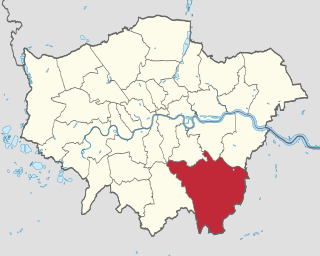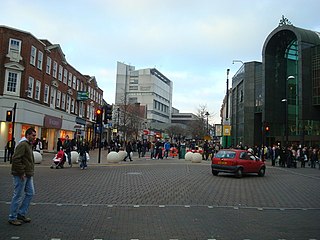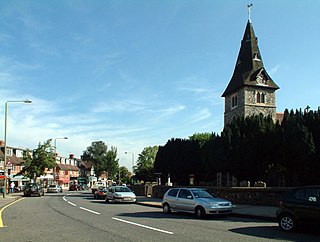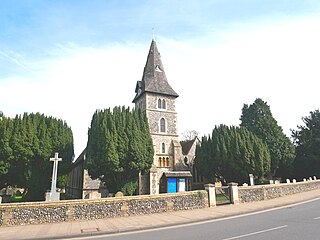
The London Borough of Bromley is the largest and southeasternmost of the London boroughs that make up Greater London, bordering the ceremonial county of Kent, which most of Bromley was part of before 1965. The borough's population is an estimated 332,336. It is named after Bromley, its principal town; other major towns are Penge, Hayes, West Wickham, Chislehurst, Beckenham and Orpington. The local authority is Bromley London Borough Council.

Bromley and Chislehurst is a constituency represented in the House of Commons of the Parliament of the United Kingdom since 2006 by Bob Neill, a Conservative.

Bromley is a large town in Greater London, England, within the London Borough of Bromley. It is 9+1⁄2 miles southeast of Charing Cross, and had an estimated population of 88,000 as of 2023.

Hayes is a suburban area of southeast London, England and part of the London Borough of Bromley. It is located 11 miles (18 km) south-east of Charing Cross, to the north of Keston and Coney Hall, west of Bromley Common, south of Bromley town centre, and east of West Wickham. An ancient parish in the county of Kent, Hayes was within the Orpington Urban District that became part of Greater London in 1965.
St Paul's Cray is an area of South East London, England, within the London Borough of Bromley in Greater London. Prior to 1965 it was within the historic county of Kent. It is located south of Sidcup and north of Orpington.

Bow Church is the parish church of St Mary and Holy Trinity, Stratford, Bow. It is located on a central reservation site in Bow Road, in Bow, in the London Borough of Tower Hamlets. There has been a church on the same site for approximately 700 years. The church was bombed in the Second World War, and the bell tower was reconstructed just after the war.

Sundridge Park, also known simply as Sundridge, is an area of Greater London within the London Borough of Bromley and prior to 1965 it was in the historic county of Kent. It is situated north of Bromley, north-west of Widmore and Bickley, south of Grove Park and south-east of Downham. In the twentieth century Sundridge names began to overlap somewhat with neighbouring Plaistow, for example, the main Sundridge shopping parade by the station sits directly east of Plaistow Green, with business and facilities in the area using the two names interchangeably, and Plaistow Cemetery is actually on the Sundridge side of the border. However, during the early twenty first century there have been deliberate attempts to re-establish the separate identities of both villages, Sundridge has its own village sign, and representation has been made to the local council for a village sign for Plaistow. Plaistow refers especially to the area north of Sundridge Park station along Burnt Ash Lane, part of the A2212 road which runs north to south between Grove Park and Bromley.
Plaistow is an area of south-east London located in the London Borough of Bromley and, until 1965, in the historic county of Kent. It is located south of Downham and Grove Park and north of Sundridge Park and Bromley. Nowadays Plaistow overlaps somewhat with Sundridge, for example the main Sundridge Park shopping parade by the station sits directly east of Plaistow Green, with business and facilities in the area using the two names interchangeably. Plaistow now refers especially to the area north of Sundridge Park station along Burnt Ash Lane, part of the A2212 road which runs north to south between Grove Park and Bromley.

The Bromley Parish Church Memorial commemorates the deceased parishioners of World War I. The war memorial was designed and constructed by British sculptor Sydney March, of the March family of artists.

St Mary the Virgin, Mortlake, is a parish church in Mortlake, in the London Borough of Richmond upon Thames. It is part of the Church of England and the Anglican Communion. The rector is The Revd Canon Dr Ann Nickson.

St Mary the Virgin is a Gothic church in South London, built in the 12th century but with notable Gothic Revival modifications and additions in the mid-Victorian period to the designs of Sir George Gilbert Scott and his son John Oldrid Scott. It is dedicated to St Mary the Virgin. In its present form, this church is a hall church with an aisled nave of three vessels of similar heights under three parallel roofs

St Mary's Church in the village of Downe, Bromley is the Church of England Parish Church for the parish of Downe. It is a Grade II* listed building, which dates from the 13th century. The church is dedicated to either St Mary the Virgin or St Mary Magdalene.

The Church Farm Industrial School for Boys was an industrial school in East Barnet. It was founded by Crimean War veteran and Pre-Raphaelite Brotherhood patron Lt Col William James Gillum in 1860 after buying a farmhouse on part of the estate of Trevor Park for use as a farm branch of Boys' Home Industrial School on Euston Road in Central London. Gillum became the first superintendent and was assisted by his wife Leonora. In 1863 it became a certified industrial school independent of the Euston Road school and began to receive boys committed to it through magistrates courts. In 1933 it became an approved school and moved to Surrey in 1937.

Potters Bar war memorial is located in St John's Churchyard in High Street, Potters Bar, England. The memorial was designed by the Arts and Crafts architect and designer C.F.A. Voysey and originally stood at the junction of Hatfield Road and The Causeway. It has been Grade II listed on the National Heritage List for England since it was moved to its present location in December 1973. Voysey's only other free standing war memorial, the Malvern Wells War Memorial, was erected in 1920 in Malvern Wells in Worcestershire.

St Matthias' Church is a Church of England parish church in Canning Town, east London. The modern building comprises a chapel, community rooms and a home for residents with disabilities.

St Philip and St James’ Church is a Church of England church in Plaistow, east London. It originated as two churches before being merged into the joint parish of St Philip and St James in 1955. That parish in its turn has now become part of the Parish of the Divine Compassion along with three other parishes in Plaistow and Canning Town - St Mary's, St Matthias' and St Martin's.

St Andrew's Church was a Church of England church on Barking Road in Plaistow, east London. It began as a small mission built in 1860 on Whitwell Road by St Mary's Church, Plaistow. A permanent church designed by James Brooks opened in 1870 on a site just south of the northern outfall sewer embankment and a separate parish assigned to it the following year. A large central crossing tower with a pyramidal spire was planned but only completed as far as the ridge of the nave roof.
St Leonard's Priory was a Benedictine nunnery in what is now east London, which gave its name to Bromley St Leonard.

St Mary's Church, Bow was a Church of England parish church in Bromley St Leonard's in east London. 'Bromley St Leonard's' was split from the parish of Stepney in 1536, reusing the priory church from the recently dissolved St Leonard's Priory, a Benedictine nunnery. It contained significant monumental sculpture.


















